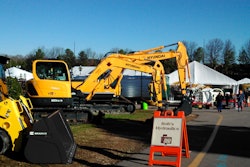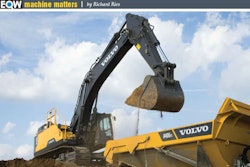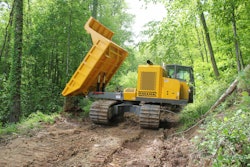
These best practices were developed from the results of a survey of users of major field service software for business-to-business companies, and Russell in turn made them applicable to equipment dealers.
(1) Fix it right the First Time (First Time Fix)
- Concept: This is always the number one need
- Best Practice: Visibility and analysis of what is not a first time fix
“You can dig in to that, making it visible, and actually having a metric on it,” Russell says. “But it’s also analyzing why certain things aren’t fixed right the first time. This gets into some bit of analysis of that.”
“It could be by service person. So look at the tech. Why is it that some have struggled with first time fix and others don’t? Is it the training or rework? Or is it a customer? Maybe a certain customer, certain applications, certain ways they treat their machines or not giving access to the machines.”
“Or it could be a product. Products have different characteristics being serviced and change over the lifecycle of a machine. Sometimes certain machines with age have certain issues that pop up. So by that end analysis, you can see where that first time fix might come back related to a machine.
(2) Communicate before, during and after service
- Concept: Tools and processes to manage many technicians and work orders
- Best practice: Multiple channels of communication; automation
“Communication, back to the service writer, back to the foreman,” Russell says. “When you’ve got some big shops that some of you have, you’ve got a lot of things going on during the day. If you’re going to set expectations, you’re going to have customers whose needs are going to change and a lot of processes that need to be there. There’s warranty work that gets done. There’s program updates as well as the regular repair work to be done.”
“So you need to have multiple channels of ways to communicate what’s going on with these various processes. And you may want to consider automating some of the things that need to be done. For example, I told that customer that I was going to get back to them on this job by the middle of the afternoon. A best practice would be to set a time on your computer for that customer that says that’s going to go off at 2:45, so I’ve got 15 minutes to call that guy back by 3 o’clock when I promised I’d get an answer back to him. Use some technology to help you with all the stresses of things going on during the day to help that communication.”
“Multiple channels might be that some people like email, some people like texts, some people like phone calls. Whatever it is, you might need multiple channels depending on your customers.”
(3) Show up when you say you will
- Concepts: Planning, real time scheduling
- Best practice: Analysis by technician or by type of service; schedule adherence
“First thing is planning,” Russell explains. “Laying it out so you know what the day looks like and where people are going to be and where they’re supposed to be. But stuff happens so you got to change in real time so the concept is changing that in real time.”
“You can look at your technicians and look at how close some people are to adhering to a schedule you give them. It might relate back to first time fix, it might be certain types of service make more issues than another. Obviously, more complicated repairs are more difficult to sort out vs. a maintenance contract and things that are just ordinary repair. So all that analysis of showing up when you say you will is your understanding of the time that it takes, and some analysis to understand that management of that time. A key thing in the service department is managing technicians’ time.”
(4) Professional appearance and organization
- Concepts: Efficiency as well as perception
- Best practice – Checklists; post work order survey
“It’s both an efficiency, a checklist and keeping things in sequence, but it’s also the perception,” says Russell. “The efficiency can be done with a checklist. Certain jobs, certain tasks. There might be an OSHA checklist, or just do you have the right tools in the truck before you leave. Did you leave with the right parts.”
“There could be some processes to put into place to make sure you’re as efficient as possible. But you might also look at surveying after the work order is done and ask what are some things I could have done better. And that survey might be a survey with a technician, it could also be with a customer asking what was the perception when that person showed up. Did they explain the job to you? When they left, did they go through how they did the job? Did they look like they were prepared? So more and more of these types of surveys could be directly related to a work order.”
(5) Fix as fast as possible
- Concepts: Understanding the problem
- Best practices – Triage; skill matching; part and tool Inventory; capturing tribal knowledge
“What some dealers are putting into place in terms of best practices is a triage,” Russell explains. “Every machine that’s going to come into the shop is going to get a two hour work order, two hours assigned to them. Your best technician is assigned to that triage. The objective in that two hours if they can fix the job if it’s just a wire loose and they hook it up and everything is fixed, great. But their main objective is to say this is the work that’s going to be needed to complete this repair on this machine.”
“This is the level of technician that is required, these are the parts that will actually be required and that triage means now I can put A level work with A level techs. And I can make sure I’ve got the parts, so when I actually start into the work I can go more efficiently. That’s the concept of triage.”
“Skill matching is A level work to A level tech. Do I have the parts and tools ready, some of the specialized tools, before I start the job, so I can fix it as fast as possible.”
“And am I capturing tribal knowledge. One of the things that happens in a lot of your dealerships is each dealership has its own culture, has its own way of doing things and transferring information within the organization. And some of it can be done mechanically, databases and so forth. It’s amazing how much stuff is done by this is “we know how to do this, here is how we do that”. And it’s a real danger because of what is happening. A lot of your best techs are baby boomers who are nearing the end of their career and they have a lot of tribal knowledge especially of older machines. Now how do I capture that? And now I’ve got newer techs working on older machines and how did I fix that older machine easily before. So capturing that is a big task for a lot of dealers now.”
(6) Schedule down time most convenient to customer
- Concepts: Know a customer’s business
- Best practice – Schedule sharing
“That’s about knowing their business, and that’s simply being able to share your schedule so you know when things are good for them,” says Russell. “Some dealerships, especially with contractors they know where and when they line up all their equipment to be ready to be fueled for the next day’s work. If you know they’re going to be there you schedule the work because you know the machines are going to be there. It’s a good time to do some of the maintenance work as well. So knowing the customer’s schedule when they’re going to have their machines can be very helpful.
(7) Fix before Failure, Predictive or Preemptive Service
- Concepts: Internet of Things, machine learning, automation, ‘Connected Service’
- Best practices – Document why service; Interntet of things, upsell service (avoid downtime cost)
“This where the biggest opportunities are to change the dynamic of the service business and help the customer to fix the machine before failure,” says Russell. “To change service from a reactive business to a preemptive, proactive service.”
“That’s where there are some of the newer technologies, such as the Internet of Things, or machine learning to learn what’s going on with the machine, and connected service comes into place. Documenting why the service is needed.”
“Now we’re into, with technology, understanding how the machine is operating and actually understanding the machine failure before it happens. This whole concept of Internet of Things and what is happening with the economy in general is going to be a huge game changer. There are going to be 25 billion devices of all kinds, whether it’s refrigerator or washing machine or your home security system, to the machines that you sell to your trucks to your tools to your smartphones, all those things connected. That’s what the Internet of Things is about.”
“And so it’s telematics, it’s proximity marketing that says I’ve now got a technician close to a machine or a machine that I know where it is and when it gets close it sends a signal. It’s also about autonomous commerce, which says I can start doing business with my customers online because they know more about me and I know more about them. This connected devices in machines is coming at us very fast. So if you’re not getting into this right now and you’re just walking, you better pick up the pace and start running into this type of connected machines.”
“There are smart machines that communicate back to a central system, so it’s a connectivity that is the ability of that service manager to know what’s going on with a machine. You now have the data to be able to spot some things and again change the nature to be predictive or preemptive into what you’re doing.”
“What you sell, though, is the value of avoiding downtime. This is costly to put all this in place. So the marketing message of that, back to the customer theme here about the pay for your investments in this because this requires some investment, is knowing what the cost of downtime is. So you’ve got to sell that and sell Mr. Customer on why we’re investing in it. Yes there’s a cost for that for me at the dealership, but I’m going to help you keep working on the job vs. not being able to.”












